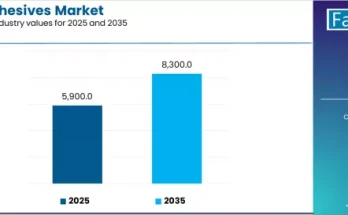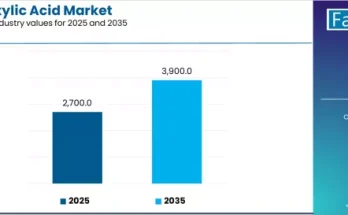The global personal care and cosmetic preservatives market stands at the threshold of a decade-long expansion, driven by rising consumer expectations for product safety, clean beauty formulations, and long-lasting shelf stability. According to a recent analysis by Fact.MR, the market is projected to grow from USD 1.3 billion in 2025 to USD 2.0 billion by 2035, advancing at a CAGR of 4.4% over the forecast period.
As brands prioritize microbiological safety and regulatory compliance, preservatives are emerging as essential components for delivering high-performance, skin-friendly beauty and personal care products.
Strategic Market Drivers
Clean Beauty and Safe Preservation Standards
The rise of clean-label formulations has redefined demand dynamics in the beauty industry. Consumers expect products that are gentle, transparent in labeling, and free from harmful substances. This shift is accelerating the use of multifunctional, broad-spectrum, and naturally derived preservatives that maintain product integrity without compromising safety or performance.
Surging Demand for Long-Lasting and Globalized Beauty Products
As cosmetics brands expand across international markets, the need for formulations that withstand variable climates, transportation conditions, and longer shelf lives is driving preservative adoption. Robust antimicrobial systems are essential for preventing contamination in creams, lotions, serums, and rinse-off products.
Growing Complexity in Formulations
Advanced emulsions, water-rich skincare, naturals-driven product ranges, and hybrid formats require more sophisticated preservation systems. This is increasing demand for synergistic blends, boosting the growth of multifunctional preservatives and barrier-enhancing technologies.
Regulatory Oversight Across Regions
Intensifying regulations in the U.S., Europe, and Asia Pacific are nudging manufacturers toward compliant, low-toxicity preservatives. This regulatory push is encouraging innovation in mild and eco-friendly preservation systems that meet global safety standards.
Browse Full Report: https://www.factmr.com/report/4638/personal-care-and-cosmetic-preservatives-market
Regional Growth Highlights
East Asia: Innovation and Volume Leadership
China, Japan, and South Korea continue to lead global consumption, powered by massive cosmetics manufacturing clusters and rapid product innovation cycles. Investment in biotech-derived preservatives and fermentation-based systems is helping the region maintain its competitive edge.
North America: Clean Beauty Powerhouse
The U.S. and Canada are witnessing strong momentum, driven by premium skincare brands, rising consumer awareness, and stringent preservative regulations. Sustainable preservation solutions and multifunctional ingredients are gaining rapid traction among formulation scientists.
Europe: Regulation-Driven Innovation
Europe remains a frontrunner in R&D due to its rigorous regulatory ecosystem. Germany, France, and the U.K. are hubs for next-generation preservative technologies, including plant-based antimicrobials and biodegradable blends suitable for natural and organic cosmetics.
Emerging Markets: Urbanization Fuels Consumption
South Asia, Latin America, and the Middle East are becoming high-growth regions as rising incomes, urban lifestyles, and beauty retail expansion fuel cosmetics consumption. Local manufacturers are rapidly adopting modern preservation systems to meet global safety expectations.
Market Segmentation Insights
By Preservative Type
- Parabens: Widely used due to efficiency and cost-effectiveness; gradually declining in certain markets due to consumer perception.
- Phenoxyethanol: Increasingly popular as a mild, effective alternative across skincare and haircare lines.
- Organic Acids and Derivatives: Preferred for natural, clean-label formulations.
- Alcohols and Quaternary Compounds: Used in high-performance and antimicrobial-intensive applications.
- Essential Oils & Botanicals: Gaining traction in natural and premium product lines.
By Application
- Skin Care: The largest segment, driven by rising demand for serums, moisturizers, and anti-aging formulations.
- Hair Care: Preservatives ensure stability in shampoos, conditioners, and treatments.
- Makeup & Color Cosmetics: Require robust microbial protection due to high-touch usage.
- Fragrances & Deodorants: Dependency on multifunctional preservation systems is growing.
Challenges and Market Considerations
Despite promising growth, the industry faces several obstacles:
- Regulatory Restrictions: Tightening norms on legacy preservatives require reformulation and ongoing R&D.
- Consumer Perception Barriers: Negative sentiment toward certain preservatives affects ingredient selection.
- Compatibility Issues: Natural preservatives pose challenges in stability, odor, and solubility.
- Cost Pressures: Demand for plant-based and biotech-derived preservatives increases production costs.
Competitive Landscape
The personal care and cosmetic preservatives market is defined by innovation-led competition. Companies are expanding their portfolios with milder, bio-based, and multifunctional preservative systems tailored for next-generation beauty products.
Key Players in the Personal Care and Cosmetic Preservatives Market
- Ashland
- Lonza Microbial Control
- Clariant
- BASF
- Dow
- Evonik
- Sharon Laboratories
- Symrise
- Thor
- Croda
These companies are investing in green chemistry, expanding global manufacturing capacities, and strengthening regulatory-compliant ingredient lines.
Future Outlook: The Era of Safe, Natural, and Smart Preservation
The next decade will reshape the preservation landscape as the beauty industry moves toward sustainability, biotechnology integration, and advanced formulation technologies. AI-driven formulation tools, eco-certified antimicrobial systems, and natural synergistic blends will define future market innovations.
With rising consumer expectations and expanding global cosmetics portfolios, the personal care and cosmetic preservatives market is positioned for long-term, resilient growth. Companies that invest in clean, compliant, and science-backed preservation systems will shape the future of safe and high-performing beauty products worldwide.



